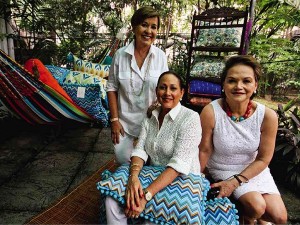
In the mid-19th century, during a time when Manila was seized by a powerful storm, an Englishman had the misfortune of getting stranded in the city.
As the next voyage for England was still three months away, this Englishman, who would then become the well-known illustrator/cartoonist Charles Wirgman, spent his days walking the streets of Manila with pad and pencils, drawing images of everyday street life.
One image shows Filipino women walking in the rain, another gentlemen in tailored suits outside a church, and yet another, soldiers’ stern faces. Call it the Victorian version of today’s street photography, executed at a time when cameras cost a fortune.
When Wirgman finally returned to London, he sifted through his collection and printed some, using wood-engraved blocks.
Today, his prints can be seen—and bought—at the first pop-up shop by Birds of Paradise at the Makati Garden Club on Recoletos Street, Edsa corner Ayala Avenue, ongoing until Sunday.
Wirgman’s story was related by print collector Isabel “Beng” Aspillera. Her trained eye for vintage prints was developed with help from husband Jose Macicior, a UK-based print dealer.
The London-based Aspillera—along with three friends from Assumption College, Madlen Faustmann, Elsie and Jenny Paradies, the ladies behind Birds of Paradise—opened the pop-up shop showcasing a treasure of unique collectible items sourced from London, Morocco, Belgium, Burma, Thailand, Indonesia and the Philippines.
“We want to offer something different, items you normally would not find in the local market. These are collections we sourced for months from antique markets and auctions. Our group is called Birds of Paradise for no special reason, other than we think birds are such colorful, flying creatures, and give much pleasure to everyone who sees them,” Aspillera said.
Aspillera also brought in prints of old maps of the Philippines, some dating back to the 17th century, which already piqued the interest of male shoppers. (For the boys, there is also an early 20th-century brass English barrel telescope mounted on a brass-and-wood tripod.) There are botanical prints, horticultural illustrations from the 1860s from Belgium, in handmade, hand-gilded red frames.
Vintage
Also seen at the pop-up shop are delicate English Victorian bamboo furniture, practical household furniture in 19th-century England that today have become decorative pieces in homes. A Victorian bamboo umbrella stand, with its own vintage umbrella, makes for an interesting conversation piece.
These light furniture pieces, some elaborately designed like most things Victorian, surprisingly survived the test of time.
“Some Victorian bamboo furniture, I had to replace the original table top, for example, with black lacquer. It was difficult to ship them here. These are very old and fragile pieces. A few got minor damages, but nothing a highly skilled craftsman can’t restore,” Faustmann said.
The flourishing artistic pursuits of the Victorian period, also called by some historians as the Second English Renaissance, is seen in the intricate and ornate designs of pressed glass and silver cutlery. If Aspillera is into prints, her friend Faustmann is into English pressed glass, and Victorian silverware and bamboo.
The handsome pressed glass on sale, from the Victorian and Edwardian periods, was carefully selected by Faustmann at auctions for a year before shipping them to the country. Molded Victorian pressed glass does not ape cut glass. But what it lacks in brilliance it makes up for in design that is distinctly Victorian—pressed glass decorated with patterns with elaborate care. On sale are pressed glass fruit bowls, dessert plates, cake stands, celery vases and so much more.
Blown and cut glass vessels were once only owned by the English gentry in the 18th century. When pressed glass was mass-produced in the Victorian period, the poor no longer drank from metal, wood or pottery.
Once a hot collector’s item in the 1980s, pressed glass has, as one of its interesting features, its registration number, where you can trace the exact day the design was registered. Faustmann carries a catalogue containing each piece’s date of registration. She herself has a collection at her home in London.
“I use them. I don’t like setting them up just for display. They just need a bit of work when cleaning, since they are not dishwasher-safe. I imagine that’s not going to be a problem here, because most Filipinos still prefer to manually wash dishes,” Faustmann said.
Birds of Paradise also features colorful Moroccan pillows and beach bags, Burmese lacquer, Chinese bowl, Victorian silver, jewelry, accessories, and Filipino crafts.